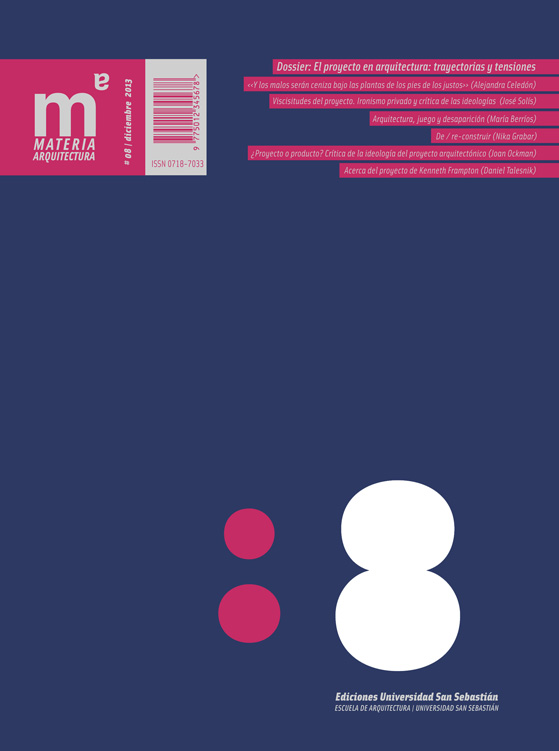Project or Product? A Critique of the Ideology of the Architectural Project
Barra lateral del artículo
Palabras clave:
Contenido principal del artículo
Resumen
They always look forward; they are an anticipation of victory over the forces of entropy in the world. But as such they demand the
jettisoning of ballast and the rejection of whatever impedes their flow. To be “postcritical“ – a term that was in vogue among architects just a few years ago – is to be without friction. In this sense the ideology of the architectural project is one of forgetting. To remind ourselves that architecture is produced, that architects are producers as well as authors, that buildings are not just finished forms but moments in a cycle of production, and that architecture strives to be beautiful in a world that is often and tragically ugly is to give the things we make a history and a conscience and to insist on the solidarity of our work with society at large.
Detalles del artículo
Materia Arquitectura proporciona acceso inmediato y gratuito a todos los contenidos de esta edición electrónica, publicada simultáneamente con la edición impresa. Materia Arquitectura no cobra honorarios a los autores por ningún concepto.
Todos los contenidos de esta edición electrónica se distribuyen bajo licencia Creative Commons de “Atribución-Copartirigual 4.0 Internacional” (CC-BY-SA).
La licencia Creative Commons permite el acceso libre e inmediato al contenido y permite que cualquier usuario lea, descargue, copie, distribuya, imprima, busque o genere enlaces a los textos completos de los artículos, permitiendo también que estos puedan ser rastreados para indexarlos, pasarlos como datos a software o usarlos para cualquier otro propósito legal. Asimismo, la licencia otorga derechos de uso a quienes a su vez utilicen una licencia abierta (Creative Commons o equivalente).
Los derechos de los textos y las imágenes publicadas pertenecen a sus autores, quienes otorgan a Materia Arquitectura la licencia para su uso. La gestión de los permisos y la autorización de publicación de las imágenes (o de cualquier material) que contenga derechos de autor y sus consecuentes derechos de reproducción en esta publicación es de exclusiva responsabilidad de los autores de los artículos.
Toda vez que mencionen su origen, los autores son libres de distribuir sus artículos por otros medios. Cualquier reproducción total o parcial del material deberá citar su procedencia.
Descargas
Citas
BARROW, L. R. (2000). Appendix 4. Case Study 2: Frank O.Gehry and Associates. En L. R. Barrow, Cybernetic Architecture - Process and Form - The Impact of Information Technology. Cambridge, MA: Harvard University (disertación PhD).
BENJAMIN, W. (1979). Reflections: Essays, Aphorisms, Autobiographical Writings. (E. Jephcott, Trad.) Nueva York: Harcourt Brace Jovanovich.
BOLTANSKI, L. & CHIAPELLO, E. (2005). The New Spirit of Capitalism. (G. Eliiott, Trad.) Londres: Verso.
DE BROSSES, C. (1760). Du culte des dieux fétiches, ou Parallèle de l’ancienne Religion de l’Egypte avec la Religion actuelle de Nigritie. París.
ENGELS, F. (1999). The Condition of the Working Class in England. Oxford: Oxford University Press.
GIEDION, S. (1954). Space, Time and Architecture (3a ed.). Cambridge, MA: Harvard University Press.
GIUFFRIDA, A. (9 de febrero de 2011). U.A.E. Construction Workers Stranded, with No Pay and No Prospects. New York Times. Recuperado de www.nytimes.com/2011/02/10/world/middleeast/10iht-M10WORKERS. html?pagewanted=all
JACOBS, A. (19 de Septiembre de 2011). China Shuts Solar Panel Factory after Antipollution Protests. New York Times. Recuperado de www.nytimes.com
MARX, K. (1976). The Fetishism of Commodities and Its Secret. En K. Marx, Capital (B. Fowkes, Trad., Vol. 1). Hammondsworth: Penguin Books.
MARX, K. (1981). The Trinity Formula. En K. Marx, Capital (D. Fernbach, Trad., Vol. 3). Hammondsworth: Penguin Books.
MUSCHAMP, H. (7 de septiembre de 1997). The Miracle in Bilbao. New York Times Magazine, pág. 72.
SMITH, J. H. & MANTZ, J. W. (2006). Do Cellular Phones Dream of Civil War? The Mystification of Production and the Consequences of Technology Fetishism in the Eastern Congo. En M. Kirsch (Ed.), Inclusion and Exclusion in the Global Arena. Londres: Routledge.
SOMOL, R. E., & WHITING, S. (2005). Okay, Here's the Plan. Log(5), 5-7.
Artículos más leídos del mismo autor/a
- Joan Ockman, ¿Proyecto o producto? Crítica de la ideología del proyecto arquitectónico , Materia Arquitectura: Núm. 08 (2013): Materia Arquitectura 08 (Diciembre/December 2013)
